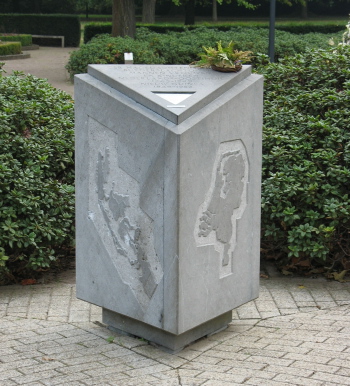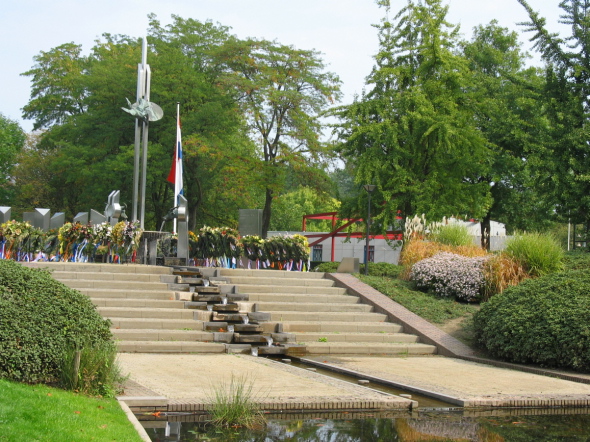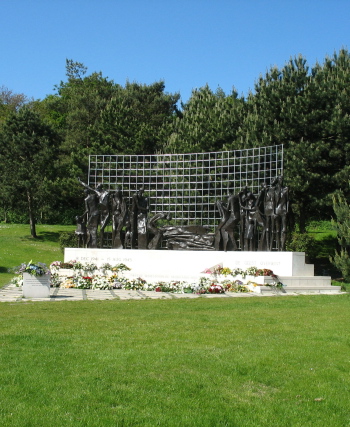Indies war memorials get a place in the Dutch landscape but the particular burden of their history remains on Indies’ shoulders
Marijke Schuurmans
The Indisch Monument in The Hague is covered with flowers almostevery dayMarijke Schuurmans |
Near a public garden in The Hague stands an eye-catching monument of the Indies, on a base of white marble. At the centre, grieving women bend over a body lying on a bier while families and couples stand by to comfort them. On their left, a man shakes his fist at the sky. Next to him, a mother encourages her child to move forward towards a better future. On the far right, a man with fists clenched at his side faces the future with determination. The figures stand in front of a high steel lattice suggesting prison bars. They represent not only the sufferings of war but also resistance to it. The openness of the steel construction also symbolises solidarity.
Each year on 15 August, the Indisch (Indies) Monument forms the backdrop for the commemoration of the Japanese surrender which ended the Second World War in the Pacific. Remarkably, it took more than fifty years for the Indisch Monument to come into existence. When it did, it was not on the initiative of the mixed group of Eurasians and Europeans with roots in the Dutch East Indies who had settled in the Netherlands after the war, where they are known as the ‘Indies community’. Not they, but Dutch officials took it upon themselves to create the monument as a sign of recognition once the time seemed right. But the gesture was controversial because it failed to recognise the pent-up emotions after years of silence and neglect. However, within a couple of years the Indies community took responsibility for the monument and made it the focus of their own activities of remembrance.
Muted memories
In the 1950s, the large-scale ‘repatriation’ of Eurasians from Indonesia to the Netherlands also brought their war experiences to Holland. During the Japanese occupation they were exempted from internment in the Japanese prison camps, but living conditions were so harsh that some went to the camps voluntarily, preferring internment over the insecurities imposed by the war. Hardship continued after the Japanese occupation ended, however, when they became a target of retaliation by Indonesian guerrilla fighters who saw them as accomplices of the colonial regime. After the transfer of sovereignty to Indonesia in 1949, Eurasians had to choose between Indonesian and Dutch citizenship. Most of them opted to be Dutch.
The war memories of the Eurasians in Holland had a certain dynamic as memories of their experiences in the Second World War were inseparable from memories of colonisation and decolonisation. However, Dutch embarrassment about their colonial past, the Japanese conquest and the violent decolonisation ensured that Indies war memories had no place in the Dutch national historical consciousness. For a long time, public recognition of their suffering was limited to an urn in the National Monument on the Dam Square in Amsterdam, a memorial in Enschede, and the Indies Plaque in The Hague. None of these were the focus of large, official commemorations.
 |
Lasting links mark the Monument for Civilian Victims in the Dutch EastIndies in RoermondMarijke Schuurmans |
But since the early 1980s new public debates and moral indignation about the colonial past led to a re-opening of this closed chapter of history. At the same time, a second generation of Indo-Dutch people raised the question of their identity, making their history and culture more visible in public as the Dutch developed growing interest for public commemorations in general. The time was ripe for official recognition.
Commemoration and criticism
In 1986 the government’s advisory committee on war memorials decided that the Indies community needed its own monument in recognition of their war experience. The intention was to establish a monument in ‘national style’, in keeping with the commemorative tradition of the National Monument on the Dam Square in Amsterdam. The Indisch Monument was dedicated to all groups who had suffered in the Second World War in Asia: armed services, civilians within and without the Japanese prison camps and ‘romushas’ (Indonesian convicts). Although not originally meant as a site for annual commemorations, since 1989 war veterans and former camp internees, their descendants and representatives from the government and from the Indies community have gathered there every year for an official ceremony. The 1989 ceremony occurred 29 years after the first official commemoration of the Japanese capitulation took place on 15 August 1970 in The Hague. A second had been held in Utrecht in 1980, marking the beginning of annual commemorations that had moved to a different place each year. It was not until 1989 that the Indies war commemoration received its own site: the Indisch Monument in The Hague.
The Indies community responded with mixed feelings to the building of the Indisch Monument. In the Indies magazine Moesson (Monsoon), some expressed relief: ‘Rather late, but I am really glad it now stands!’ Others were more sceptical: ‘Nice monument for Buchenwald. No trace of Indies, no bamboo, no barbed wire. To me that monument is of no significance.’ Several Indies spokespersons stated that the community has no need for a monument in ‘national style’, because they had given the war a place in their own circles. Some criticised the initiators for failing to recognise that, for the Indies community, the war didn’t end with the Japanese surrender. Critics also regretted that an Indies artist had not been commissioned to design the monument. The advisory committee had chosen the design of a Dutch-Bulgarian artist, considering her sculpture most appropriate because in it ‘the war elements of the Indies situation’ were ‘forged together with more general and pervasive emotions of grief, violence and despair. There were also expressions of resistance, tenacity and solidarity’ thus making the monument recognisably speak for all. But many in the Indies community felt that it failed to recognise ‘their’ memories.
The foundation responsible for the monument responded to these criticisms by adding an ‘Indies touch’ to the monument. In 1989, the monument was made to seem more ‘tropical’ by the addition of bamboo plants (which were later removed because the roots threatened to destabilise the monument). At the fiftieth anniversary of the Japanese capitulation in 1995, an ‘Indies bell’ in a bell cradle was added placed behind the monument. At the sixtieth anniversary in 2005, a small column was placed in front of the monument containing earth from the seven Dutch war cemeteries on Java. Three years later an urn containing earth from the Dutch war cemetery in Ambon was added to this column. The Indies community generally appreciated these ‘Indies’ additions. But was it enough? No ‘Indies touch’ could substitute for explicit recognition of the forgotten war experience after the Japanese surrender.
Remembering forgotten victims
What the monument in The Hague lacked, other monuments made up for. In the same year that the government unveiled the Indisch Monument in The Hague, another memorial was erected in Roermond to honour war veterans who had fought on Dutch side during Indonesia’s struggle for independence. This National Indies Monument is a complex of several separate monuments that developed over the years into one vast commemorative site. It started with a basin in the shape of a sawah (rice field) which is flanked by two bronze heads of water buffalo and a huge steel column topped with a bronze sun. There is also a bronze bird of paradise representing the last Dutch colonial territory of New Guinea (now Papua), which passed into Indonesian control in 1962. Later additions include ten steel columns engraved with the names of fallen soldiers, a bust of general Spoor (who led the military actions against Indonesia’s independence fighters) and a pavilion in Minangkabau style, with high peaked roofs with upswept eaves, named after him Like the Indisch Monument, this commemorative site was not the initiative of the Indies community, but the proposal of Dutch citizens of Roermond – the city from which military troops and volunteers were dispatched to the Indonesian archipelago to ‘restore order’.
 |
The Dutch military side of the story at the National Indies MonumentMarijke Schuurmans |
Two years later, representatives of the Indies community unveiled a second memorial in Roermond, the Monument for Civilian Victims in the Dutch East Indies to honour ‘the forgotten group of war victims’. One side of this small triangular sculpture of solid concrete shows an image of the Indonesian archipelago, the other side an image of the Netherlands. A niche filled with Indonesian earth was later added to the sculpture, visible through a glass plate. Another symbolic reference to the former colony on this civilian monument in Roermond, as on the Indisch Monument in The Hague, is the text ‘the spirit overcomes’, which is also written on monuments at Dutch war cemeteries in Indonesia. For the Indies community, such symbolic connections with Indonesia help to reduce the physical and spiritual distance between the country of their past and the country of their present.
However, there have been no commemorations at the civilian monument in Roermond since 2005. Many Indies people commemorate their war experiences in their own environment, and for this purpose they have created various local memorials dedicated to specific events. More importantly, the function and meaning of the Indisch Monument in The Hague has broadened to include the violent period after the Japanese surrender. And the original ‘Dutch national style’ of this commemorative statue has been softened with some personal touches.
‘Today is your 103rd birthday, daddy Miel’, reads a birthday card placed at the rear of the Indisch Monument. Now, almost every day Indies people visit the monument to place flowers for lost loved ones, either at birthdays, the day of a relative’s death, or after funerals and cremations. So many Indies people choose this site to scatter the ash of deceased relatives that a special field has been created for this purpose facing the monument. It matters little, then, that the meaning and purpose of the Indies monument and the commemorative activities taking place there remain largely unknown to most Dutch people. To the Indies community it has become theirs, a place for personal memories to be honoured.
Marijke Schuurmans (marijkeschuurmans@gmail.com) is an art historian specialising in (post)colonial cultural heritage. She graduated from the Department of Art, Religion and Cultural Sciences at the University of Amsterdam. Currently she is a research assistant at the project ‘Future of the war heritage’ at the Netherlands Institute for War Documentation (NIOD).












